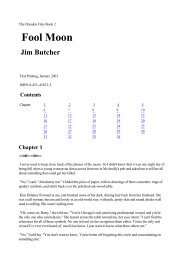Monster Geographica - Marsh & Aquatic.pdf - The Secrets of the ...
Monster Geographica - Marsh & Aquatic.pdf - The Secrets of the ...
Monster Geographica - Marsh & Aquatic.pdf - The Secrets of the ...
Create successful ePaper yourself
Turn your PDF publications into a flip-book with our unique Google optimized e-Paper software.
3<br />
Whipstriker<br />
Large Animal<br />
Hit Dice: 6d8+6 (33 hp)<br />
Initiative: +5<br />
Speed: 20 ft. (4 squares), swim 60 ft. (12<br />
squares)<br />
Armor Class: 13 (-1 size, +1 Dex, +3<br />
natural), touch 10, flat- footed 12<br />
Base Attack/Grapple: +4/+11<br />
Attack: Bite +6 melee (1d8+3)<br />
Full Attack: Bite +6 melee (1d8+3) and<br />
2 claws +4 melee (1d6+1) or tail slap +4<br />
melee (2d6+3)<br />
Space/Reach: 10 ft/5 ft. (10 ft. with tail)<br />
Special Attacks: Improved grab, trip<br />
Special Qualities: Low-light vision<br />
Saves: Fort +6, Ref +6, Will +1<br />
<strong>The</strong> powerfully built reptile is almost 12 feet<br />
long, although roughly half <strong>of</strong> that is its strong,<br />
whiplike tail. Its blunt snout is lined with rows<br />
<strong>of</strong> razor-sharp teeth that curve backward, and its<br />
reddish-black hide has a rough, pebbly texture.<br />
Combat<br />
<strong>The</strong> whipstriker remains deathly still until<br />
<strong>the</strong> moment <strong>of</strong> attack, nearly always catching its<br />
prey by surprise. A whipstriker dragged out onto<br />
dry land is still a formidable opponent, using its<br />
whiplike tail to knock its victims <strong>of</strong>f <strong>the</strong>ir feet.<br />
If a whipstriker gets a hold, it grabs <strong>the</strong><br />
opponent with its mouth and drags it into deep<br />
water, attempting to pin its prey to <strong>the</strong> bottom.<br />
Improved Grab (Ex): To use this ability,<br />
a whipstriker must hit with its bite attack. It can<br />
<strong>the</strong>n attempt to start a grapple as a free action<br />
without provoking an attack <strong>of</strong> opportunity. If it<br />
Flora and Fauna<br />
62<br />
Abilities: Str 16, Dex 13, Con 13, Int 2, Wis<br />
9, Cha 5<br />
Skills: Climb +7, Hide +0*, Jump +11,<br />
Listen +2, Move Silently +5, Spot +2, Swim<br />
+11<br />
Feats: Alertness, Improved Initiative,<br />
Multiattack<br />
Environment: Temperate and warm aquatic<br />
and underground<br />
Organization: Solitary<br />
Challenge Rating: 3<br />
Alignment: Always neutral<br />
Advancement: 7-12 HD (Large); 13-18 HD<br />
(Huge)<br />
Level Adjustment: —<br />
wins <strong>the</strong> grapple check, it establishes a hold and<br />
deals automatic bite damage each round <strong>the</strong> hold is<br />
maintained.<br />
Trip (Ex): A whipstriker that hits with its<br />
tail slap attack can attempt to trip <strong>the</strong> opponent (+7<br />
check modifier) as a free action without making a<br />
touch attack or provoking an attack <strong>of</strong> opportunity.<br />
If <strong>the</strong> attempt fails, <strong>the</strong> opponent cannot react to<br />
trip <strong>the</strong> whipstriker.<br />
Skills: A whipstriker has a +4 racial bonus<br />
on Climb and Jump checks.<br />
A whipstriker has a +8 racial bonus on any<br />
Swim check to perform some special action or<br />
avoid a hazard. It can always choose to take 10 on<br />
a Swim check, even if distracted or endangered. It<br />
can use <strong>the</strong> run action while swimming, provided<br />
it swims in a straight line.<br />
* A whipstriker has a +10 racial bonus on<br />
Hide checks when submerged.<br />
Greater bladderwort: An aquatic plant found in swampy conditions. Camouflaged in its<br />
environment, this nine-foot long rootless plant feeds on insects, crustaceans, and larvae. It catches and<br />
digests its prey in translucent sacs that grow along <strong>the</strong> stalks <strong>of</strong> <strong>the</strong> plant. <strong>The</strong> sacs (5 mm across) have<br />
trapdoors and valves that maintain lower pressure inside <strong>the</strong> sacs. When prey triggers <strong>the</strong> trap, touching<br />
antennae around <strong>the</strong> trap door, <strong>the</strong> valve relaxes and sucks <strong>the</strong> creature in <strong>the</strong> sac. <strong>The</strong> trap door shuts, and<br />
<strong>the</strong> digestive juices start pumping.







